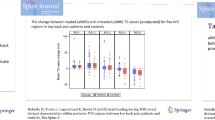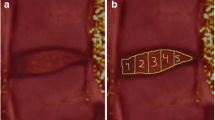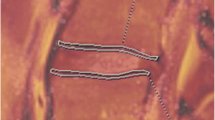Abstract
Purpose
To investigate whether axial loading of the spine during MRI (alMRI) instantaneously induces changes in biochemical disc features as reflected by altered quantitative T2 values in patients with chronic low back pain (LBP).
Methods
T2 mapping was performed on 11 LBP patients (54 lumbar discs) during the conventional unloaded MRI and subsequent alMRI. Each disc was divided into five volumetric regions of interests (ROIs), anterior annulus fibrosus (AF) (ROI 1), the interface anterior AF-nucleus pulposus (NP) (ROI 2), NP (ROI 3), the interface NP-posterior AF (ROI 4), and the posterior AF (ROI 5). The mean T2 values for each ROI were compared between MRI and alMRI and correlated with degeneration grade (Pfirrmann), disc angle, and disc level.
Results
With alMRI, T2 values increased significantly in the whole disc as well as in various parts of the disc with an increase in ROI 1–3 and a decrease in ROI 5. The changes in T2 values correlated to degeneration grade, changes in disc angle, and lumbar level.
Conclusion
alMRI instantaneously induces T2-value changes in lumbar discs and is, thus, a feasible method to reveal dynamic, biochemical disc features in patients with chronic LBP.




Similar content being viewed by others
References
Dagenais S, Caro J, Haldeman S (2008) A systematic review of low back pain cost of illness studies in the US and internationally. Spine J 8:8–20. doi:10.1016/j.spinee.2007.10.005
Bogduk N, Aprill C, Derby R (2013) Lumbar discogenic pain: state-of-the-art review. Pain Med 14:813–836. doi:10.1111/pme.12082
Raj PP (2008) Intervertebral disc: anatomy–physiology–pathophysiology-treatment. Pain Pract 8:18–44. doi:10.1111/j.1533-2500.2007.00171.x
Samartzis D, Borthakur A, Belfer I, Bow C, Lotz JC, Wang HQ, Cheung KM, Carragee E, Karppinen J (2015) Novel diagnostic and prognostic methods for disc degeneration and low back pain. Spine J 15:1919–1932. doi:10.1016/j.spinee.2014.09.010
Lotz JC, Fields AJ, Liebenberg EC (2013) The role of the vertebral end plate in low back pain. Glob Spine J 3:153–164. doi:10.1055/s-0033-1347298
Fields AJ, Han M, Krug R, Lotz JC (2015) Cartilaginous end plates: quantitative MR imaging with very short echo times-orientation dependence and correlation with biochemical composition. Radiology 274:482–489. doi:10.1148/radiol.14141082
Chou R, Fu R, Carrino JA, Deyo RA (2009) Imaging strategies for low-back pain: systematic review and meta-analysis. Lancet 373:463–472. doi:10.1016/S0140-6736(09)60172-0
Endean A, Palmer KT, Coggon D (2011) Potential of magnetic resonance imaging findings to refine case definition for mechanical low back pain in epidemiological studies: a systematic review. Spine 36:160–169. doi:10.1097/BRS.0b013e3181cd9adb
Manchikanti L, Glaser SE, Wolfer L, Derby R, Cohen SP (2009) Systematic review of lumbar discography as a diagnostic test for chronic low back pain. Pain Physician 12:541–559
Wang YX, Zhao F, Griffith JF, Mok GS, Leung JC, Ahuja AT, Yuan J (2013) T1rho and T2 relaxation times for lumbar disc degeneration: an in vivo comparative study at 3.0-Tesla MRI. Eur Radiol 23:228–234. doi:10.1007/s00330-012-2591-2
Welsch GH, Trattnig S, Paternostro-Sluga T, Bohndorf K, Goed S, Stelzeneder D, Mamisch TC (2011) Parametric T2 and T2* mapping techniques to visualize intervertebral disc degeneration in patients with low back pain: initial results on the clinical use of 3.0 Tesla MRI. Skelet Radiol 40:543–551. doi:10.1007/s00256-010-1036-8
Hoppe S, Quirbach S, Mamisch TC, Krause FG, Werlen S, Benneker LM (2012) Axial T2 mapping in intervertebral discs: a new technique for assessment of intervertebral disc degeneration. Eur Radiol 22:2013–2019. doi:10.1007/s00330-012-2448-8
Yu HJ, Bahri S, Gardner V, Muftuler LT (2015) In vivo quantification of lumbar disc degeneration: assessment of ADC value using a degenerative scoring system based on Pfirrmann framework. Eur Spine J 24:2442–2448. doi:10.1007/s00586-014-3721-0
Boos N, Boesch C (1995) Quantitative magnetic resonance imaging of the lumbar spine. Potential for investigations of water content and biochemical composition. Spine 20:2358–2365 (discussion 2366)
Mwale F, Iatridis JC, Antoniou J (2008) Quantitative MRI as a diagnostic tool of intervertebral disc matrix composition and integrity. Eur Spine J 17(Suppl 4):432–440. doi:10.1007/s00586-008-0744-4
Takashima H, Takebayashi T, Yoshimoto M, Terashima Y, Tsuda H, Ida K, Yamashita T (2012) Correlation between T2 relaxation time and intervertebral disk degeneration. Skelet Radiol 41:163–167. doi:10.1007/s00256-011-1144-0
Marinelli NL, Haughton VM, Anderson PA (2010) T2 relaxation times correlated with stage of lumbar intervertebral disk degeneration and patient age. Am J Neuroradiol 31:1278–1282. doi:10.3174/ajnr.A2080
Watanabe A, Benneker LM, Boesch C, Watanabe T, Obata T, Anderson SE (2007) Classification of intervertebral disk degeneration with axial T2 mapping. Am J Roentgenol 189:936–942. doi:10.2214/AJR.07.2142
Blumenkrantz G, Zuo J, Li X, Kornak J, Link TM, Majumdar S (2010) In vivo 3.0-tesla magnetic resonance T1ρ and T2 relaxation mapping in subjects with intervertebral disc degeneration and clinical symptoms. Magn Reson Med 63:1193–1200
Stelzeneder D, Kovacs BK, Goed S, Welsch GH, Hirschfeld C, Paternostro-Sluga T, Friedrich KM, Mamisch TC, Trattnig S (2012) Effect of short-term unloading on T2 relaxation time in the lumbar intervertebral disc—in vivo magnetic resonance imaging study at 3.0 tesla. Spine J 12:257–264. doi:10.1016/j.spinee.2012.02.001
Stelzeneder D, Welsch GH, Kovacs BK, Goed S, Paternostro-Sluga T, Vlychou M, Friedrich K, Mamisch TC, Trattnig S (2012) Quantitative T2 evaluation at 3.0 T compared to morphological grading of the lumbar intervertebral disc: a standardized evaluation approach in patients with low back pain. Eur J Radiol 81:324–330. doi:10.1016/j.ejrad.2010.12.093
Maquer G, Brandejsky V, Benneker LM, Watanabe A, Vermathen P, Zysset PK (2014) Human intervertebral disc stiffness correlates better with the Otsu threshold computed from axial T2 map of its posterior annulus fibrosus than with clinical classifications. Med Eng Phys 36:219–225. doi:10.1016/j.medengphy.2013.11.008
Hebelka H, Brisby H, Hansson T (2014) Comparison between pain at discography and morphological disc changes at axial loaded MRI in patients with low back pain. Eur Spine J 23:2075–2082. doi:10.1007/s00586-014-3408-6
Willen J, Danielson B (2001) The diagnostic effect from axial loading of the lumbar spine during computed tomography and magnetic resonance imaging in patients with degenerative disorders. Spine 26:2607–2614
Pfirrmann CW, Metzdorf A, Zanetti M, Hodler J, Boos N (2001) Magnetic resonance classification of lumbar intervertebral disc degeneration. Spine 26:1873–1878
Landis JR, Koch GG (1977) The measurement of observer agreement for categorical data. Biometrics 33:159–174
Cheung KM, Karppinen J, Chan D, Ho DW, Song YQ, Sham P, Cheah KS, Leong JC, Luk KD (2009) Prevalence and pattern of lumbar magnetic resonance imaging changes in a population study of one thousand forty-three individuals. Spine 34:934–940. doi:10.1097/BRS.0b013e3181a01b3f
Splendiani A, Perri M, Grattacaso G, Di Tunno V, Marsecano C, Panebianco L, Gennarelli A, Felli V, Varrassi M, Barile A, Di Cesare E, Masciocchi C, Gallucci M (2016) Magnetic resonance imaging (MRI) of the lumbar spine with dedicated G-scan machine in the upright position: a retrospective study and our experience in 10 years with 4305 patients. Radiol Med (Torino) 121:38–44. doi:10.1007/s11547-015-0570-9
Silcox DH 3rd, Horton WC, Silverstein AM (1995) MRI of lumbar intervertebral discs. Diurnal variations in signal intensities. Spine 20:807–811 (discussion 811–812)
Ludescher B, Effelsberg J, Martirosian P, Steidle G, Markert B, Claussen C, Schick F (2008) T2- and diffusion-maps reveal diurnal changes of intervertebral disc composition: an in vivo MRI study at 1.5 Tesla. J Magn Reson Imaging 28:252–257. doi:10.1002/jmri.21390
Acknowledgments
The study was supported by a regional Grant under the ALF agreement, number 428161 to HB, and by a grant to HH from Gothenburg Medical Society. The sponsors of the study had no influence on the analysis and interpretation of data; nor in the writing of the report. The authors would like to thank the MRI staff at Molndal Hospital, Gothenburg, Sweden, for the pleasant co-operation.
Author information
Authors and Affiliations
Corresponding author
Ethics declarations
Conflict of interest
None.
Rights and permissions
About this article
Cite this article
Nilsson, M., Lagerstrand, K., Kasperska, I. et al. Axial loading during MRI influences T2-mapping values of lumbar discs: a feasibility study on patients with low back pain. Eur Spine J 25, 2856–2863 (2016). https://doi.org/10.1007/s00586-016-4670-6
Received:
Revised:
Accepted:
Published:
Issue Date:
DOI: https://doi.org/10.1007/s00586-016-4670-6




